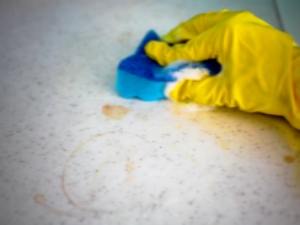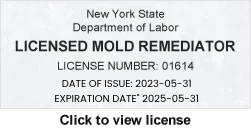
Staining vs Etching
Two very common discolorations that can happen to natural stone are staining and etching. While they may appear to be similar, they are really two completely different things. The restoration process for each one is different.
What is a stain?
A stain happens when a substance like spaghetti sauce, coffee or red wine is left on the stone long enough for it to soak into the stone pores and cause discoloration. A stain usually darkens the stone. When you rub your hand over it, you can’t feel it. (Just like when you spill something on your shirt and don’t treat it right away).
Can staining be prevented? Yes!
Staining can be prevented by:
- Having your tops sealed at initial installation.
- Cleaning up all spills right away.
- Using a stone-safe cleaner to perform routine cleaning. Some stone-safe cleaners have a bit of stone sealer in them. (Never seal over a stain. That locks it in place and makes it much more difficult to remove).
- Periodically having your stone deep cleaned and resealed.
What can I do if I get a stain on my stone?
Don’t panic. Most stains can be removed successfully. Here are some quick tips:
- Figure out what kind of stain it is. Knowing what it is helps to decide the correct treatment.
- Consult our Stain App under the Resources tab on this site.
- If you are unsure or if the stain did not come out, please contact us.
What is etching?
Etching happens when something acidic, like vinegar, strong cleaning solutions, lemon juice, or strawberries, is left on the stone long enough for the acid to actually eat away some of the surface minerals of the stone. An etch will usually lighten the stone and will feel rougher to the touch than the rest of your stone surface. The etched area will also lose its shine and appear duller than the surrounding polished areas.
Can etching be prevented? YES!
Etching can be prevented by:
- Cleaning up all spills immediately.
- Using coasters under glasses.
- Using pH-neutral or stone-safe cleaners.
- Not relying on stone sealers. Sealing your tops will not prevent etching. Sealing only helps prevent stains.
What can I do if my stone gets etched?
Again, don’t panic. Here are some quick tips:
- If the area is small or the etching is minimal, you may be able to use a stone polishing compound to remove the etch. Consult our Stain App for detailed instructions.
- If the etching is severe, contact us. You don’t want to risk making it worse.
- If there is a stain in the etch, treat the stain first and then the etch.
Natural stone is beautiful and very versatile, but sometimes damage will happen. The great thing about natural stone is that most stains and surface damage can be removed. With the proper natural stone restoration processes, your stone can look beautiful for years to come.
By Sharon Koehler. This article is one of a series of articles written and published on behalf of Surface Care PRO Partners.




